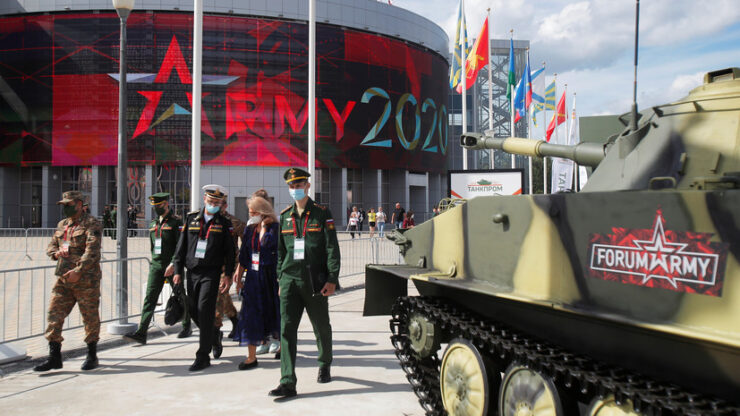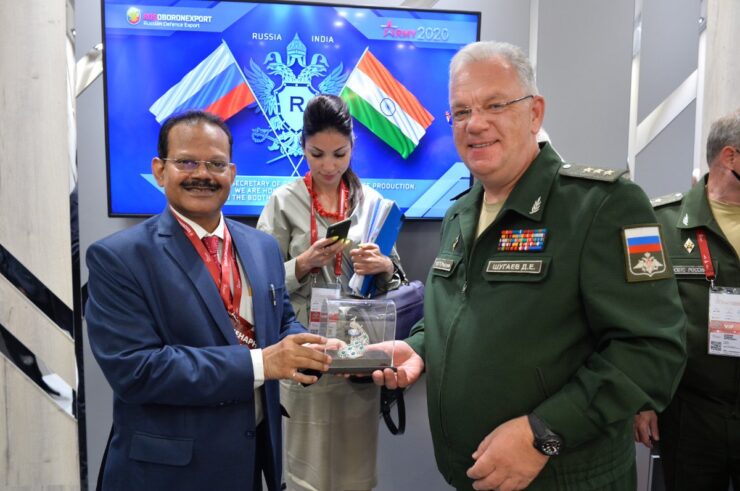
The week long Army 2022 Expo in Moscow from August 15 amid the ongoing Russo-Ukrainian war saw Russia make a strong pitch with India on defence cooperation specially in the area of defence equipment seeking to dissuade India from being dependent on Ukraine for engines, and expressing immense interest in being part of Make in India initiative.
India had procured gas turbine engines from Ukraine and handed them over to Russia to install them on the Admiral Grigorovich-class guided-missile stealth frigates being made for the Navy.
Claiming that Russia is no longer dependent on Ukrainian engines to power its frigates, the head of Russian United Shipbuilding Corporation (USC) said they are willing to invest in India as part of the Atmanirbhar Bharat initiative.
“I don’t know why India went in for a Ukrainian engine when we have now built our own capability and capacity. We are no longer dependent on Ukraine for engines,” USC President Alexei Rakhmanov said on the sidelines of the Army 2022 Expo.
India had procured gas turbine engines from Ukraine and handed over to Russia to install them on the Admiral Grigorovich-class guided-missile stealth frigates that are being made for the Indian Navy by a Russian shipyard as part of a $2.5 billion deal.
While two ships are being built in Russia, two others are to be built at the Goa shipyard with Russian help. India had ordered Ukrainian engines for the ones being built in Goa, but reports say that the delivery had not taken place yet. One of the targets of the Russian missile attacks on Ukraine was the production facility of these gas turbine engines. It is not yet known what will happen to the two frigates that are to be built in Goa, with the engines being undelivered and the factory hit.
Speaking about the delivery schedule of the two frigates, Rakhmanov said the first would be delivered by November 2023 and the next within six months of it.
“We are trying to fast track the delivery and fill up the gap,” Rakhmanov said. According to the original delivery schedule, the first ship was to be handed over by the end of this year.
Meanwhile, with the West imposing further sanctions against Russia, the two countries India and Russia are working on new payment system for defence deals. They had worked out a simpler system for payments, but secondary sanctions imposed on Russia have led to fresh challenges. The two sides are now working out a new payment system for defence equipment already ordered, including leasing of the third nuclear submarine.
Currently, one of the major areas of concern which is causing anxious moments to India is appreciation of the Russian rouble vis-à-vis rupee. This means payment to Russia becomes more expensive for India. In August last year, both rupee and the Russian rouble had the same value. But the Russian rouble is today valued at 0.75 against one rupee.
Asked about the impact of western sanctions on India-Russia defence deals, Russia’s Federal Service for Military Technical Cooperation (FSMTC) head Dmitry Shugaev said payments are made in accordance with the terms stipulated in the contracts.
“As a result of the anti-Russian campaign unleashed by unfriendly countries, domestic military-technical cooperation entities, leading enterprises of the military-industrial complex and financial institutions are subject to various types of sanctions. In this regard, payments in the US dollar and Euro in arms export transactions have been reduced to a minimum,” he said.

With more new sanctions imposed on Russia, it has led to fresh challenges and Russia has been pushing for a rupee-rouble transfer as a payment system for defence deals for the last few years, but India had been reluctant, given the depreciation in the Russian currency. However, now, the Russian currency has appreciated.
While India and Russia had worked out a simpler system for payments, the secondary sanctions imposed on Russia and other nations, including France following its invasion of Ukraine, has created fresh challenges.
The US, along with the European Union, have cut off seven Russian banks from SWIFT — the Belgium-based cross-border payment system operator – including the one that was being used for payments earlier by India. The slapping of newer sanctions and cutting off Moscow from SWIFT has impacted the payment capacity.
According to Russian sources some payments have fallen behind and both Moscow and New Delhi are in touch with each other to arrive at a solution.
“Today, Russian exporters of military products, like the entire economy, are operating in a new reality. Large-scale work is underway. State corporations and military-technical cooperation entities are in constant cooperation with financial institutions of our country, our foreign partners,” Shugaev said.
He said to counter this, Russia has taken up a tailored approach to each of its customers offering attractive conditions when concluding contracts, adjusting the payment forms and providing more flexible schemes, abandoning the dollar and switching to other currencies, including national ones.
However, larger payments are an issue but talks are underway to ensure no delivery gets affected.
Russia has proposed the use of a SWIFT-like system developed by the Russian central bank. It involves rupee-rouble-denominated payments using Russia’s messaging system, SPFS. Under the proposal, rupees will be deposited to a Russian bank and converted into roubles. However, some undecided elements include whether the exchange rate will be fixed or floating.
Emphasising that Russia is the only country in the world which can actually do a complete Transfer of Technology (TOT) in hi-tech defence equipment, it said it wants to build the next generation armoured vehicles and submarines in joint collaboration with India.
Undeterred by the sanctions, Russia said it has stood by its contractual obligations and delivery of all systems, including the S-400 air defence system, as per schedule.
“Work is underway to organise the production of the AK-203 assault rifles in India, the serial production of which is expected to begin in late 2022-early 2023. The implementation of contracts for the construction of Project 11356 frigates in Russia and India is also proceeding as planned. The current geopolitical situation has not significantly affected the fulfilment of our obligations,” Shugaev said.
The head of FSMTC, which deals with all military related deals and commercial cooperation with other countries, said the Russian Federation traditionally offers India the cutting edge models of weapons and military equipment.
“Russia is the only country that engages in large-scale cooperation with India in the field of sophisticated military technologies including transfer of knowhow to Indian partners. During more than 60 years of military-technical cooperation, our countries have, in fact, implemented the principle of Make in India,” he said.
“With our assistance, dozens of types of high-tech military products have been localised in India. The current stage of our relations in this area of cooperation is distinguished by India’s desire to accelerate the development of its national military-industrial complex, reduce the dependence on imports of military products and join the ranks of the world’s leading arms exporters.
“We support this desire and are ready for industrial cooperation, looking for joint projects that, on the one hand, would be beneficial for Russian and Indian enterprises, and, on the other, would ensure our relations reach a new level of technological partnership,” he said.
Asked what these were, he said, “A future main battle tank, infantry fighting vehicle, fifth-generation aircraft, diesel-electric submarines and other types of modern weapons.”
Taking a dig at western countries, he said, “Once again I want to emphasise that Russia is ready for the widest technological cooperation, unlike the Western so-called ‘partners’, who promise a lot, but in fact are not very eager to share advanced technologies with India.”
Shugaev noted that many countries today were planning to set up their own military production through the transfer of technology and the acquisition of competencies. One of the leaders in this sphere is, of course, India, which implements the Make in India program, he said.
“We do understand these trends and are ready to flexibly respond to them. We have a number of similar projects with India — the BRAHMOS missile, the localisation of tank rounds, and Kalashnikov assault rifles, and the construction of ‘11356 frigates’ at an Indian shipyard,” he said.
He said both India and Russia have the potential to build mutually-beneficial cooperation in the supply of weapons and military equipment. All types of Russian-made military equipment are widely represented in the Indian armed forces — land, sea, aviation and air defence.
“All Russian-made military products supplied for export have an envisaged potential for upgrade, and the equipment delivered to India is no exception. In addition to upgrading, there are other areas of cooperation between our countries, such as creating conditions for servicing the delivered weapons and equipment in India, as well as jointly producing various types of equipment and weapons for sale in third countries,” Shugaev said.








